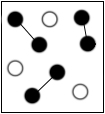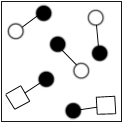Elements, compounds, atoms and molecules
This task is about atoms, elements, compounds, and mixtures.
 |
 |
 |
 |
 |
| A | B | C | D | E |

| a) |
Use the boxes above to answer these questions.
|
||||
| i) |
Name a box that contains an element.
|
A B C D E (Circle one)
|
|||
| ii) |
Which box contains a compound?
|
A B C D E (Circle one)
|
|||
| iii) |
Which box contains a mixture of elements?
|
A B C D E (Circle one)
|
|||
|
Four words that can be used when describing substances are written in the box below.
|
|||||
|
|||||
|
b)
|
Use these words to explain the difference between
|
||||
| i) |
box B and box D.
|
||||
| ii) |
box A and box B.
|
||||
| c) | Using symbols like those in boxes A to E, draw a diagram below to show a box containing two different types of compounds. | ||||
|
|||||


